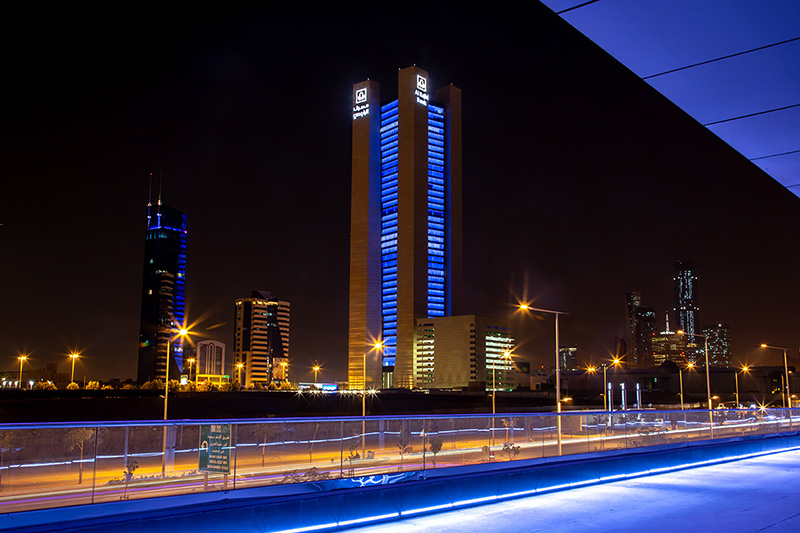With rebounding economies, effective vaccinations and uncountable state interventions that sustained operating environments, the global banking sector bounced back and stabilised much faster than conceivable from its net negative outlook at the onset of 2021. While the pandemic has caused a significant increase in bank credit losses, the global banking sector has shown resilience and continues to slowly stabilise itself as the economic rebound gains momentum, despite the possibility of re-intensification of risks as state support is gradually withdrawn.
For Al Rajhi Bank, one of the world’s largest Islamic banks, navigating strategically through challenging global, regional, local and sector specific trends during the year under review made a significant impact on the Bank’s performance.
Global trends
The global health crisis resulting from the pandemic continued well into 2021, with second, third and even fourth waves of COVID-19 and its variants spreading across the world and cautioning investors. However, major stimulus packages coupled with successful vaccine rollouts across advanced economies provided some much anticipated relief and signs of uneven growth, while not completely exempting countries with high vaccination rates from negative economic and social impacts. However, gaps in recovery between advanced economies and low-income developing nations continued to widen in 2021, with global geopolitical dynamics including the US-China decoupling threat, Russia-West tensions and EU’s foreign policy agenda further contributing to slowing economic recovery.
During the year under review, Central Banks across the world had varied inflation responses that reflected each country’s recovery efforts, giving rise to concerns that the world economy as a whole was entering a period of weak growth and high inflation reminiscent of the 1970’s ‘stagflation’. This together with global supply chain disruptions outweighed COVID-19 as the biggest risks to domestic and corporate growth in 2021, even though more transmissible COVID-19 variants such as Delta and Omicron may have extended global inflationary pressures. Given the extremely high uncertainties including the spread of new COVID-19 variants, the International Monetary Fund (IMF) stressed that major Central Banks should remain vigilant, and carefully communicate their future stance of monetary policy to avoid market panic and unwarranted tightening of financial conditions when swift action is called for.
Measures of inflation expectations for the medium and long-term remain close to policy targets in most economies. This reflects, in addition to expectations of waning inflationary forces, that policy actions can bring inflation back to target. Even as employment rates remained below pre-pandemic levels, headline inflation rates have increased rapidly in US as well as emerging and developing economies in recent months, although with differences in the extent of price pressure. To a large degree, the increase in inflation reflects a combination of pandemic-induced supply-demand mismatches and policy-related developments with exchange rate depreciations contributing to higher import goods prices in some countries.
In the near to medium term, fiscal policy remains key to address the impacts of the still-evolving pandemic; fiscal policy continues to be accommodative and shift towards longer-term investments such as digital transformation and green transition in many advanced economies, while emerging markets and developing countries continued shifting expenditures toward addressing pandemic-related challenges. Higher interest rates and lower government revenues have strained the capacity of low-income developing countries to provide fiscal support and service their debt, making it clear that the reduction in deficits can only occur largely through lower spending. Overall, while fiscal policy remains supportive with 2021 deficits falling by about 2 percentage points of GDP on average, they are still well above pre-pandemic levels, especially in advanced economies. Deficits are projected to decrease further by almost 3 percentage points in 2022 and return to pre-pandemic levels by 2026.
Responding to the growth of cryptocurrencies was one of the top priorities for policymakers and regulators in 2021. Crypto asset markets grew rapidly, overlapping with key parts of the global monetary and financial system, but crypto asset prices remained highly volatile. Furthermore, the volume of crypto asset transactions reached macro critical levels in some emerging markets, often as high as those of domestic equities. A sound regulatory framework for crypto assets and decentralised finance markets more generally remains a priority on the global policy agenda.
Across the world, financial markets are beginning to integrate climate transition risks and opportunities into investment decision-making, with policy shifts toward long-term social and environmental issues. In 2021, The United Nations issued a Global Roadmap with a set of 150 commitments and USD 400 Bn. to support both energy transition and energy access for all by 2030 and net-zero emissions by 2050. The IMF recommended a number of initiatives that can help advance the proposed energy transition in an equitable way, while also emphasising on the delivery of the annual USD 100 Bn. in climate financing that high-income nations promised the world’s low income nations as way back as 2009.
Global government debt remained at a record-high — just below 100% of GDP in 2021, and is projected to decrease slightly through 2026. Large purchases of government debt by central banks especially in advanced economies and by the domestic banking sector have helped contain the cost of new borrowing. The debt build-up has led to many low-income, developing countries needing further international aid, and in some cases debt restructuring.
The Debt Service Suspension Initiative (DSSI) introduced by G20 countries to the world’s poorest countries for a temporary suspension of debt-service payments in 2020 continued through till December 2021. This was followed by the G20 Common Framework to help low-income countries restructure their debt and deal with insolvency and protracted liquidity problems. The international community also scaled-up its financial support, including record IMF emergency lending and a USD 650 Bn. allocation of special drawing rights (SDRs) — USD 21 Bn. of which was allocated directly to low-income countries. The G20 leaders committed to support low-income countries with on-lending USD 100 Bn. of their SDRs to significantly magnify this impact. With the DSSI expiring in 2022, low-income countries should aim to benefit from the Common Framework to unlock IMF financing.
While most sectors had begun their digital journeys pre pandemic, for a majority of organisations the COVID-19 outbreak, its mobility restrictions and resulting labour market inequalities meant an acceleration of digital transformation and automation by months or even years, out of which a service-sector productivity growth emerged during 2021. Across the globe, businesses automated processes, modified business models and adopted emerging technologies including Artificial Intelligence (AI), 5G and enhanced connectivity, Edge Computing, Internet of Behaviours (IoB), Quantum Computing, Blockchain, Cybersecurity, Human Augmentation, Distributed Cloud, Virtual and Augmented Reality, Robotic Process Automation (RPA) to name a few.
In global equity markets, equity prices have risen despite recent market turbulence, boosted by extremely low, declining real rates and strong earnings. In the corporate bond market, credit spreads—a market-based measure of default risk—have remained tight, reflecting investors’ benign view of the credit outlook amid ample liquidity and continued policy support. Investors appear to have become somewhat more cautious, demanding more protection against large declines in risk markets amid increased uncertainty about the economic outlook. According to the IMF, elevated equity valuations and increased sensitivity of equity prices to government bond prices suggest that equity markets may re-price substantially in the event of a sudden reassessment of the economic outlook or unexpected policy changes.
In corporate taxes, G20 leaders endorsed a global initiative backed by 136 countries in 2021 to set a 15% minimum tax rate of 15% for multinationals with an annual revenue above USD 865 Mn. The agreement is intended to curb the benefits seen by large companies that shift profits overseas to tax havens, which supporters of the deal argue has limited the amount of tax revenue countries are able to collect.
The IMF estimates that comprehensive growth-enhancing reforms cutting across product, labour, and financial markets could raise annual growth in GDP per capita by over one percentage point in emerging markets and developing economies in the next decade. In an era of low real interest rates, small increases in economic growth can have very large impacts on debt sustainability. Strong household spending, inventory restocking and growth in capital spending during 2021 supported global economic activity to gain steadier footing in the medium-term, with a healthy economic rebound, higher trade volumes and investments expected to lead global economies to normalcy in 2022.
Regional trends
Across the Middle East and Central Asia (MECA) region, there have been clear signs of a pickup in trade and supportive global financial conditions with resilient banking systems, but risks such as weak employment and increasing inequities are also building unevenly.
The wide range of policy responses across the region played a key role in protecting livelihoods and vulnerable populations and in mitigating economic, banking, and corporate sector risks. Some regional countries such as Oman introduced new measures in 2021 to support small and medium enterprises and vulnerable households, while emergency spending measures in other countries were kept the same, reduced or allowed to expire. Certain below-the-line liquidity support measures without a direct budgetary cost have remained in place.
Policy interest rates remain low for many countries. Some of the macro-financial measures introduced such as the loan guarantee programme and waivers for electronic transaction fees in Saudi Arabia have expired. Other measures such as credit subsidies, credit guarantees and loan repayment deferrals in Gulf Cooperation Council (GCC) countries were extended.
The regional outlook for 2022 remains promising, with oil exporters, particularly GCC countries, standing to benefit from higher oil prices and the recovery in global demand, with spill-over effects to the rest of the region. As the region prepares for a new journey in the post-pandemic world, the crisis presents opportunities that could lead to a transformational recovery marked by more resilient, inclusive, and greener economies. Domestic policies would need to be comprehensive and exploit synergies to enable this transformation. Global and regional cooperation will also be crucial for vaccine deployment and leveraging digitalisation, adaptation to climate change, and transition to lower carbon dependence to strengthen the region’s medium-term growth prospects.
Recovery seemed uneven in other regions across the world; Consumer confidence had diminished in Europe as the pandemic lingered, with supply chain disruptions, rising energy prices and labour shortages contributing to the imbalance. In the US, rapid vaccine rollout, strong government stimulus, and the swift lifting of restrictions has pushed back the economy to growth, but remained below pre-pandemic forecast levels by the end of 2021.
The Chinese economy on the other hand entered a mature stage in its Covid-19 recovery, with decreasing domestic demand counterbalanced by strong export performance. However, excessive investment and borrowing worsened during the pandemic and prompted the Chinese government to impose tighter restrictions on the real estate sector, private sector, environmental and energy markets. This has led to financial solvency problems for large Chinese real estate companies and renewed concerns about a potential credit downturn. Chinese property developers’ debts appear big enough to crash the national economy, but several factors could limit the real estate downturn and the threat of global financial contagion. The risk of a global real estate bubble also emerged in 2021, with rising housing demand driving home prices to historic heights, last seen in the mid 1970s and mid-2000s, ahead of major recessions.
Local trends
The surge in oil prices has been a key driver to fuel a strong economic recovery across the Kingdom, while also affording the government a buffer to maintain fiscal discipline. The non-oil sector expanded as output and new business increased on the back of these improved economic conditions and easing of Covid-19-induced restrictions during the latter half of the year.
Demand for crude oil soared in 2021 when OPEC and its allies (OPEC+) extended its production cuts into April, successfully rebalancing the global oil market, drawing down inventories and raising prices as demand recovered. Towards the second half of 2021, OPEC+ nations decided to increase production driven by a rise in global demand due to easing COVID-19 restrictions. Under the OPEC+ agreements framework in 2021, KSA’s daily average production as well as average daily exports increased despite further voluntary production cuts. With plans to increase the Kingdom’s production share in early 2022 in-line with the OPEC+ agreement, the recovery of global demand and improvement in global supply chains will reflect positively on the domestic economy next year.
In the Budget Statement for 2022, Saudi Arabia forecast 2.9% GDP growth in 2021 attributed to higher oil prices and a stronger than anticipated domestic demand. In 2022, the Kingdom projects a 7.4% GDP growth sustained by higher oil prices and production and by a stronger domestic and external demand, which would be supported by the improvement in global supply chains. Budget estimates for 2022 show that total revenues will reach SAR 1,045 Bn., an increase of 12.4% compared to projected revenues in 2021.
The Kingdom expects to post its first budget surplus of 2.5% of GDP in 2022 as revenues are expected to increase driven by oil price recovery, rising crude production volumes and tightening of spending plus higher taxes. If achieved, this surplus will be the first since oil prices crashed in 2014. These surpluses will be directed to boost government reserves, support national development funds and the Public Investment Fund, channelled towards accelerating the implementation of some strategic programmes and projects with economic and social dimensions, or to partially repay the public debt based on market conditions. Public debt indicators are expected to improve in 2022, declining to 25.9% of GDP, down from 29.2% in 2021. Inflation reached 3.3% during the year under review, but is expected to decelerate in 2022 to 1.3% as the impact of the VAT increase fades.
The major elements that stand out in the 2022 Budget Statement are indications of steady improvement in all major economic and fiscal matrices, while still adopting a conservative approach to budgeting oil and non-oil revenues. This will help to support government efforts to sustain economic growth. According to the budget statement, Education, Health, Military and General Items are expected to continue as the main expenditure targets in 2022.

The private sector is expected to lead economic growth and job creation in 2022 driven by the National Investment Strategy – a key enabler to deliver on Vision 2030 goals including raising the private sector’s contribution to GDP to 65%, reducing the unemployment rate to 7%, increasing the contribution of non-oil exports to GDP from 16% to 50%, and positioning the Kingdom among the top ten economies in the Global Competitiveness Index by 2030.
Locally in Saudi Arabia, the policy focus in 2021 was directed towards raising investment levels to help meet diversification objectives and involve more private sector participation. The government continued its efforts to further develop its debt and equity markets, push up local investments (Shareek Programme), and increase foreign direct investment in the country to reach Vision 2030 objectives through the revision of regulatory frameworks. Under Vision 2030, the Saudi government continued economic and fiscal reforms through initiatives such as the Fiscal Sustainability Programme, a medium-term fiscal planning mechanism that aims to sustain public finances and achieve a balanced budget, while enhancing fiscal discipline and controlling budget deficit levels.
With the launch of Vision 2030 to develop and diversify the Saudi economy, the Kingdom continued to increase non-oil exports to minimise the dependency on oil sales, and achieve the goal of raising foreign direct investment from 3.8% to an international average of 5.7% of GDP by 2030. Healthcare experienced major transitions and investments including the launch of the Health Sector transformation Programme (HSTP) within the framework of Vision 2030. Technology, logistics, real estate, ‘Made in Saudi Arabia’ Programme and the Privatisation Programme were among other non-oil initiatives that were announced by the Ministry of Finance in the 2021 budget.
The continuation of Mega projects such as the futuristic smart city Neom, the Red Sea land and property development project, entertainment mega project Qiddiya and super-luxury tourism project Amaala are all expected to boost growth in nascent sectors such as entertainment and tourism, and create investment opportunities across the Kingdom. Non-oil GDP grew by 4.8% in 2021, with the private sector projected to grow at a higher pace to lead economic growth and job creation in 2022.
The Kingdom also continued to scale up its climate action and environmental protection through the Saudi Green Initiative, unifying all sustainability efforts in the Kingdom through a clearly defined and ambitious roadmap to increase reliance on clean energy, offset the impact of fossil fuels and achieve global targets in combating climate change. The Kingdom has over 60 environmental and clean energy initiatives in the pipeline to reach three targets under the Saudi Green initiative, among which reducing carbon emissions by 278 mtpa by 2030 remains a key objective in the Kingdom’s journey to reach net zero by 2060.
As the effects of digitisation continued to reshape the local operating environment, the Kingdom’s aim remained on becoming a regional hub in emerging technologies and digital transformation, with the government realising qualitative achievements via a roadmap that measures and defines a new digital economy.
The Kingdom is in negotiations with multiple countries including the US, India, Australia and China on possible free-trade agreements, and aims to export services including professional and financial services, communication services, postal services as well as transport, media, construction and contracting, education and training, travel and tourism, environmental, and entertainment services.
The IHS Markit Saudi Arabia Purchasing Managers’ Index™ (PMI) posted 53.9 by December; the reading was the lowest since March indicating a solid improvement in operating condition across the non-oil private sector. Results of the December 2021 Primary Consumer Sentiment Index (PCSI) in Saudi Arabia revealed concerns about the global spread of the Omicron variant leading to a marked slowdown in new business growth.
Sector-specific trends
Islamic financial markets continued to expand in 2021, as demand for Sharia-compliant products remained resilient. In 2022 and beyond, it is expected that Islamic finance will continue to expand, maintaining its now long-established growth trend. The sector is expected to continue growing on all fronts, including banking, sukuk, takaful and insurance, with this growth benefiting from supportive government policies that reflect strong and increasing demand for such products.
Despite the challenging economic environment, pent-up demand and disposable income will support sales and increase average selling prices as mortgage loans are expected to continue expanding thanks to favourable funding conditions and government stimuli. Additionally, the expected surplus in public finances would accelerate the implementation of some strategic programs and projects with economic and social dimensions.
A robust asset quality will be supported by strong credit growth, which will benefit from mortgage growth, capital projects under the Public Investment Fund (PIF), and the involvement of the private sector in Vision 2030-related investments. Banks will maintain stable funding profiles and adequate capital. Higher interest rates will support banks’ profitability.

LIBOR – the global interest rate benchmark – will no longer be available for financial transactions from 31 December 2021 as it continues to be phased out across the world after decades of dominance. Saudi Arabia is moving to the Federal Reserve-approved Secured Overnight Financing Rate (SOFR).
The Basel Committee’s January 2023 implementation date for Basel IV is approaching rapidly, with banks expecting to hear in 2022 what will be required of them. Regulators are sticking to the need for completion of the final reforms although some banks question the timing. Implementation has been deferred once due to the pandemic and may be delayed further due to the regulatory process.
In terms of Public-Private Partnerships, there have been several successful build-own-operate and build-operate-transfer projects implemented across the Kingdom, mainly in the power and water sectors. Moreover, areas such as waste management, the metro, and similar mass transit projects have utilised or planned on using the private sector along the value chain.
Government supportive measures to promote sustainability of the SME sector such as the Kafalah programme, National Development Fund and Private Sector Financing Support Programme reactivated credit for the SME segment in 2021, and witnessed a growth of 28% YoY according to SAMA. At the onset of the fourth and final quarter of 2021, SAMA also reported that Commerce (16.7%), Manufacturing (8.3%) and Construction (5.0%) were the sectors with the highest exposure. For banks, key concerns in financing these sectors include new waves of COVID-19, supply chain instability, resulting business interruptions, scarcity of materials and workforce shortages.
Overall, KSA Cost of Funds (COF) was the lowest in GCC in 2021 due to the rapid increase in deposits across Saudi banks. For 2022, deposit growth is expected to stabilise and this, together with the rapid financing book growth would lead banks to enter the debt market. Interest rates are expected to move in tandem with the U.S. Federal Reserve, and hence, increase COF.
In conclusion, continued economic recovery will support profitability, asset quality and low loan losses in the banking sector. Solid capital positions, improved loan loss reserves and sufficient liquidity will safeguard the Saudi Banking sector credit profile. Lower interest rates and higher cost of risk resulting from the gradual phase-out of government stimuli will put pressure on profitability, which would be partially offset by expanding the financing book, higher margins and by easing impairments and provisioning costs.
 ANNUAL REPORT 2021
ANNUAL REPORT 2021





